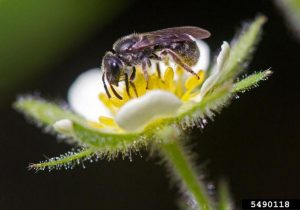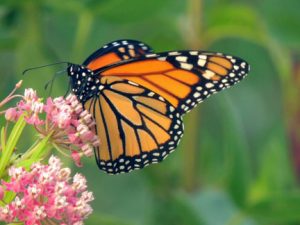Agronomy, Conservation, Homepage Slider
Practices that Promote Birds, Bees, and Butterflies
By James Hoorman, Hoorman Soil Health Services
The birds are chirping while bees and butterflies will soon be flying as spring starts to blossom. Pollinators are an important food source for over 4,000 species of wild native bees and 725 species of butterflies in North America. The monarch butterfly population has declined dramatically and may soon be an endangered species. Many wild bees, flies, and butterflies pollinate many crops humans consume. Providing healthy pollinator habitat is a way to preserve these beneficial species.
The annual value of insect pollinated crops is $29 billion per year and about 80% of flowering plants need pollinators to survive according to a Cornell study. Domestic honey bees hive loss is estimated to be 30% annually but only a 15% loss is acceptable. USA honey sales are about $5 billion per year with Ohio pollinator services valued at 216 million. Most of the decline in pollinators is the result of a loss of pollinator habitat and pesticides which either kill or weaken certain species and makes them susceptible to diseases and mites.
The domestic honey bee only pollinators about 33-40% of our crops. Native wild bees like bumble bees, ground nesting, and wood tunneling bees generally increase domestic honey bee pollinating efficiency along with other native flies and insects. Bumble bee colonies contain no more than 300 bees while domestic honey bees have 30-50 thousand bees. Bumble bees may have a lower number, but they are extremely efficient at pollinating flowers due to their long tongue. Bumble bees are the favorite pollinator in most greenhouse operations and are used to pollinate strawberries, plums, zucchinis, melons, sweet peppers, tomatoes as well as seed crops like alfalfa, red clover, cotton, and sunflower. Wild bees tend to make domestic bees more skittish, which means they move more often from flower to flower which increases pollinator efficiency.
The ideal farm setting for bee and butterfly conservation are smaller fields (10 acres) separated by fencerows or buffer strips. A diversity of flowering plants throughout the growing season offers these pollinators refuge and extra food. Most wild bees only forage a short distance from their nests, often less than 200 yards while domestic honey bees may travel 4 miles round trip. Two-thirds of all native bee species nest underground so they need a stable habitat to survive.
Bees and butterflies like diverse crops with diverse flowers. Ideally, promote nectar early spring, mid-summer, and late fall. For early spring; dandelions, henbit, and crimson clover are great pollinators. Kale and rapeseed can be pollinators for certain species. For mid-summer flowers, plant buckwheat, winter peas, and flowering legumes like sweet clover, hairy vetch, red clover, white clover, and alfalfa. In late fall, sunflower, wild carrot (Queen Ann’s Lace), and goldenrod make great pollinators. Keep soils high in SOM (mulch) and biological activity to provide a winter refuge for native species. To attractive humming birds, try planting cardinal flowers. For butterflies pollinators try common milkweed, swamp milkweed, asters, butterfly bush and wild lupine.

Farmers need to be aware of how they may increase bee and butterfly termination when using air-assisted planters. Neonicotinoids (Poncho, Cruiser, Gaucho) are used as seed treatments with a talc coating to improve seed flow. When farmers raise and lower their planters or clean out their planters, the dust can be extremely toxic to foraging bees and butterflies. There is enough seed treatment on one kernel of corn to kill an entire hive of domestic bees.
Purdue University suggests eliminating or reducing flowering weeds in fields before planting. Also, avoid adding excess dust from the bottom of the seed container to the planter. Follow planter recommendations for use of talc or graphite (avoid using more than recommended) and minimize off-site movement of dust. Especially around bee hives or sensitive areas, plant in early morning or in the evening when bees tend to be less active. Be aware of wind speed and direction, especially in regards to nearby areas with flowering plants that could attract pollinators.
Other considerations include making sure the seed is being placed into the soil and not exposed on the soil surface, especially on end rows and corners. Clean planters and seed boxes away from sensitive environmental areas, especially those that are attractive to pollinators. Use a broom or shop vacuum cleaner to minimize dust release and if compressed air is used, take care to minimize dust release. All these precautions may help reduce bee and butterfly die off and improve the environment for everyone to enjoy.